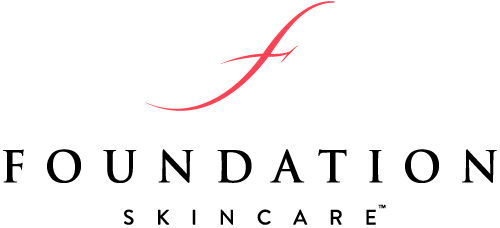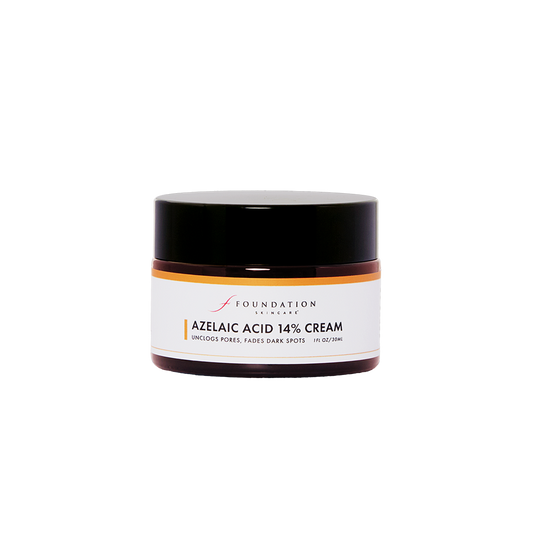Foundation Skincare Azelaic Acid vs The Ordinary Azelaic Acid
Ideal for people who struggle with acne, hyperpigmentation, rosacea, and other inflammatory skin conditions, azelaic acid is a skin-friendly antioxidant that helps to neutralize the free radicals that lead to environmental damage in all types of skin. Though it is trending in the beauty industry at the moment, it has been used by dermatologists for more than 30 years.1
In the past, a prescription was needed to reap the benefits of azelaic acid, but now there are a number of over-the-counter products making this ingredient more accessible. Two such products are Foundation’s medical-grade Azelaic Acid Cream 14% and The Ordinary Azelaic Acid 10% Suspension, which is described as a “cream-like formula.” Find out how the two products compare, how long it takes to see results, and what you should expect when you add azelaic acid to your skincare routine.
Purpose
The dermatologist-formulated Azelaic Acid 14% Cream was created to target skin conditions such as mild rosacea, acne, skin irritations, and pigmentation disorders like melasma, hyperpigmentation, and brown spots. With its antibacterial and anti-inflammatory properties, azelaic acid kills acne-causing bacteria on your skin and disrupts the link between increased levels of testosterone and other hormonal changes to help minimize hormonal breakouts. The product also helps block the process of pigment production in skin cells, which happens naturally due to sun exposure, effectively brightening the complexion.
Foundation’s Azelaic Acid 14% Cream helps brighten skin tone and visibly improve skin texture through its antioxidant support. It is ideal for those looking to even skin tone, prevent acne, and revive dull skin and has a medical-grade concentration, which is the highest you can get without needing a prescription. The formula is hydrating enough to use as a moisturizer, so it will not dry out skin or make it more sensitive to the sun. It works well with other Foundation products, which can be layered for optimal effects, especially those containing niacinamide and hyaluronic acid.
The Ordinary Azelaic Acid 10% Suspension is a cream-like product that contains a lower concentration of azelaic acid than the Foundations formulation. It should be used with a moisturizer to lock in benefits and prevent the skin from drying out. The manufacturers recommend not using this product with those containing niacinamide, peptides, direct acids, or retinoids because The Ordinary Azelaic Acid is silicone-heavy. Silicones have a blocking effect on the skin, which means anything applied after it will not penetrate the skin. There is a chance the silicones can also cause irritation when debris and oil get trapped under the barrier.2
Ingredient Breakdown
With its 14% concentration, Foundation’s Azelaic Acid Cream is considered medical-grade. Most over-the-counter products with azelaic acid do not contain more than 10% of the ingredient. At the same time, most prescriptions contain 15-20% azelaic acid, which tends to dry out the skin and cause irritation. We find that 14% is the sweet spot to make a significant improvement in the skin’s condition without causing irritation. Some other key ingredients found in the formulation include:
- Aloe leaf juice: This succulent plant is known for its soothing properties. It has hydrating, emollient and anti-inflammatory benefits and creates a protective barrier on the skin.
- Vitamin E: With antioxidant properties, vitamin E softens skin, protects cells from damage, and even helps reduce sun damage by absorbing UVB rays. Vitamin E has also been shown to reduce your skin’s inflammatory response, reducing swelling and reddening.3
The Ordinary Azelaic Acid contains the standard concentration of azelaic acid in most over-the-counter products at 10%. Though this concentration can help produce desired results, several studies show that higher concentrations of the active ingredient are more effective and comparable to prescription strength.4
The product also contains vitamin E, but not aloe leaf juice. In addition, it also contains another ingredient called triethanolamine, which is an emulsifier and pH adjuster made by the reaction of aqueous ammonia and ethylene oxide.5 There is some evidence this ingredient may be a health hazard. Additionally, the product contains phenoxyethanol, which may cause allergic reactions or worsen eczema.6 The product is also silicone-heavy, containing dimethicone, dimethicone/bis-isobutyl ppg-20 crosspolymer, and polysilicone-11. These silicones are not great for layering, as they block subsequent ingredients from reaching the skin and can trap debris and oil, upping the chances of irritation and acne flare-ups.
Azelaic Acid 14% Cream
• Brightens skin, fades brown spots
• Unclogs pores, improves texture
How to Use Them
With Foundation’s Azelaic Acid Cream 14%, the product should be applied last in your skincare routine, but before sunscreen for a morning application. It can be used twice daily, but be sure to use a pea-sized amount as a little goes a long way. The ingredient has a cumulative effect, so it’s important that you use it consistently. Feel free to layer with other products like Niacinamide Lotion 10% which calms skin and contributes to DNA repair. You can also use Hyaluronic Acid Lotion, which works as a magnet for skin hydration.
The Ordinary Azelaic Acid can also be used twice daily after cleansing and water-based serums and before oils, suspensions, or creams. It should also be used in conjunction with sunscreen. Patch testing is strongly advised.
Results
With Foundation’s Azelaic Acid Cream 14%, users typically notice significant improvements in their rosacea and acne in just 30 days.
- After 6-8 weeks, you’ll notice less redness and a softer feel. Flare ups will be reduced and heal faster as bacteria is destroyed and skin cell turnover increases.
- After 3 months, skin conditions should be considerably improved, with skin texture, brightness and hyper-pigmentation under control and inflammation reduced. These effects may be more noticeable and occur faster when combined with other products.
When using The Ordinary Azelaic Acid, some users report seeing changes in their skin within weeks while others have seen no results after several months of using the product.7 Using the Ordinary product in combination with other products may offer more pronounced effects, but certain products can also cause irritation or dryness, so results should be closely monitored.
Overview
It’s undeniable that both products have positive effects on the skin, as azelaic acid is a superstar ingredient, but they do vary in a few key ways. Here’s a quick overview of the differences between these popular skincare products.
The Ordinary Azelaic Acid 10% Suspension:
- Lower concentration of azelaic acid.
- Includes a few ingredients associated with negative health outcomes and does not contain aloe leaf juice.
- May cause irritation when used with other products like those containing niacinamide, peptides, direct acids, or retinoids.
Foundation Azelaic Acid Cream 14% :
- Higher concentration of azelaic acid, which makes it medical-grade.
- Contains aloe leaf juice helps to prevent drying out the skin or causing irritation.
- Well-rounded blend of ingredients scientifically proven to support skin health.
- Can be combined with other products without causing irritation.
Though The Ordinary’s product is an inexpensive choice when it comes to azelaic acid products, if you’re looking for a medical-grade product (without the prescription), then you may prefer Foundation’s Azelaic Acid Cream product. Suitable for all skin types and easy to add to your regimen, the product is dermatologist-formulated with carefully chosen ingredients proven to make a difference in your skin.
And if you want an extra edge in stopping pigmentation at the source, pair the cream with Pigmentation Defense, a supplement containing a blend of antioxidants, vitamins and herbs to improve hyperpigmentation supports healthy skin turnover.
Learn more about how to use azelaic acid and why you should.
References:
-
https://link.springer.com/article/10.1007/BF03001692
-
https://www.healthline.com/health/beauty-skin-care/silicones#6-reasons-not-to-like-silicone
-
https://health.clevelandclinic.org/vitamin-e-for-skin-health/
-
https://practicaldermatology.com/articles/2013-mar/new-insights-into-azelaic-acid
-
https://pubchem.ncbi.nlm.nih.gov/compound/Triethanolamine
-
https://www.safecosmetics.org/chemicals/phenoxyethanol/
-
https://www.sephora.com/product/the-ordinary-deciem-azelaic-acid-suspension-10-P427411





